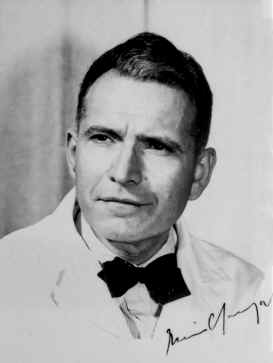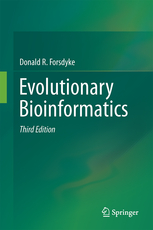|

Published
by Springer (2016)
A
substantial revision of the second edition (2011)

Books on bioinformatics
began appearing in the mid 80s and primarily served gene-hunters, and
biologists who wished to construct family trees showing tidy lines of
descent. Given the great pharmaceutical industry interest in genes, this
trend has continued in most subsequent texts. These deal extensively
with the exciting topic of gene discovery and searching databases, but
hardly consider genomes as information channels through which multiple
forms and levels of information, including genic information, have
passed through the generations.
This book identifies the types of
information that genomes transmit, shows how competition between
different types is resolved in the genomes of different organisms, and
identifies the evolutionary forces involved. The early chapters relate
the form of information with which we are most familiar, namely written
texts, to the DNA text that is our genome. This lends itself well to
introducing historical aspects dating back to the nineteenth century.
Third edition revisions include expansion of the section on brain bioinformatics. All sections are
updated with references. Attention is drawn
to a new series of online tutorials for beginners in the field. |
| Notes on Second
and Third Editions |
XVII |
| Prologue
-
To Select is Not To Preserve
|
XXIII
|
| |
|
|
| Chapters |
|
|
| Part
I. Information and DNA
|
|
| 1 |
Memory
- A Phenomenon of Arrangement
|
3 |
| 2 |
Chargaff's
First Parity Rule
|
25 |
| 3 |
Information
Levels and Barriers
|
43 |
| |
|
|
| Part
II. Parity and Non-Parity |
|
| 4 |
Chargaff's
Second Parity Rule
|
63 |
| 5 |
Stems
and Loops
|
83 |
| 6 |
Chargaff's
Cluster Rule
|
103 |
| |
|
|
| Part
III. Variation and Speciation |
|
| 7 |
Mutation |
121 |
| 8 |
Species
Survival and Arrival |
141 |
| 9 |
The Weak Point |
157 |
| 10 |
Chargaff's GC Rule |
175 |
| 11 |
Homostability |
193 |
| |
|
|
| Part
IV. Conflict within Genomes |
|
| 12 |
Conflict
Resolution
|
209 |
| 13 |
Exons
and Introns
|
235 |
| 14 |
Complexity
|
253 |
| |
|
|
| Part
V. Conflict between Genomes |
|
| 15 |
Self/Not-Self?
|
279 |
| 16 |
The
Crowded Cytosol
|
305 |
| |
|
|
| Part
VI. Sex and Error-Correction |
|
| 17 |
Rebooting
the Genome
|
327 |
| 18 |
The
Fifth Letter
|
351 |
| |
|
|
| Part VII.
Information and Mind |
|
|
19 |
Memory
- What to Arrange
and Where |
367 |
|
20 |
Certainty Now Uncertain
|
381 |
| |
|
| |
|
|
|
Epilogue
-
To Preserve is Not To Select
|
395 |
|
Appendix
A What the Graph Says |
409 |
|
Appendix
B
Scoring Information Potential |
415 |
|
Appendix
C Selection Level for PR2? |
419 |
|
Appendix
D
K-mer Probabilities and Genome Size |
421 |
|
Appendix E No Line?
|
425 |
| |
|
|
Acknowledgements |
435 |
|
Index |
439 |
ISBN-13:978-3319287539 104
illustrations (20 in
colour) 13 tables eBook $189.00 Hardcover $249.00
For e-book: (Click Here)
For institutions with access to a Springer eBook package,
students can purchase a low-price black and white softcover edition, and
individual chapters may be downloaded as PDF files
(Bookmetrix records for the 2nd edition 21470 downloads between Sept 2012
and Jan 2017)
(Bookmetrix records for the 3rd edition 21018
downloads between April 2016 and March 2018)

|
Read
the Reviews
Phillip Guddemi's Review
in Cybernetics & Human Knowing
(2016) 23(3): 93-103
The book - -
consolidates a revolution in thinking that is contained in
Forsdyke's earlier publications, for example his 2001 book
The Origin of Species Revisited. Like many
revolutions Forsdyke's is catalyzed by a renewed look at the past.
Specifically, he has revived a number of questions about
evolutionary process which were raised in the 19th Century by
William Bateson - who was Gregory Bateson's father and the inventor
of the word genetics - and by the essayist Samuel Butler - - . These
questions deal with the fundamental issue of the origin of species
and how they diverge, but because they point away from natural
selection as the only and total explanation they have by and large
been ignored by the mainstream of evolutionary theorizing. - -
Forsdyke goes far to show how processes which either can directly
be called schismogenesis, or which might be analytically related
to schismogenesis-processes which cannot be understood without
very sophisticated molecular genetic analysis, and yet may have
been anticipated conceptually by Butler among others-might be the
answer to hybrid sterility and thus to some of the problems
relating to the origins of species that niggled at William Bateson
in his later years. By treasuring his conceptual exceptions, WB
recognized that there was a residue problem that had not been
fully explained by Darwin or by Mendel. Forsdyke has directly
contributed to addressing that residue and explaining it in a 21st
Century way. |
|

Return to: HomePage
(Click Here)
Go to: Evolutionary Bioinformatics
Second Edition (Click Here)
Go to: Evolution Page (Click Here)
Go to: Bioinformatics Page (Click Here)
Go to: Introductory
Videos (Click Here)

|







